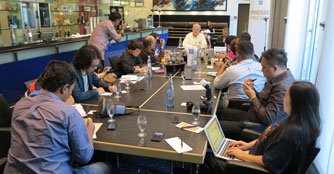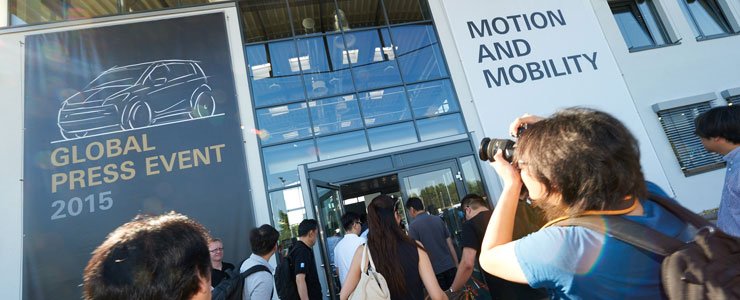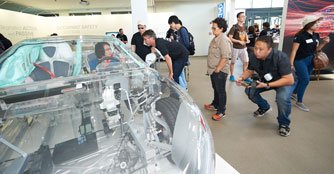An insight to the road ahead for ZF TRW Automotive Holdings Corp
10 Jul 2015|7,914 views
When ZF Friedrichshafen AG successfully acquired TRW Automotive on May 15th this year, the world eagerly waited to see what the marriage of these two leading automotive parts and systems manufacturers would bring to the table.

and headcount, but also in a compelling product portfolio.
Renamed as ZF TRW Automotive Holdings Corp, the company will be able to offer solutions such as hybrid or purely electric drives, brake technology, safety and solutions that connect the steering, active chassis and stability program systems.
We got to meet the President of ZF Asia Pacific, Rudi von Meister, in Potsdam, Germany, for a roundtable interview and these were the discussions that ensued.
SGCM: Congratulations on your 100th year anniversary, as well as the acquisition of TRW. What was the main driving force for ZF in the acquisition of TRW?
RVM: One of the key reasons for the acquisition of TRW was to bring into the ZF family, technologies that enable ZF to be a more effective and comprehensive player in the automotive technologies industry. Be it braking, steering, efficiency, safety or autonomous driving, it is important for ZF to add these technologies into our business model to remain competitive. TRW's experience and knowledge in these aspects, compliment the products of ZF.
SGCM: What is the long term plan for TRW and will the brand name be retained or slowly phased out?
RVM: TRW is a well-established and a highly-respected global brand and we will be seeing that brand well into the future. As a corporate identity, we will incorporate TRW into ZF as a fifth and new division called Active & Passive Safety Technology.
 |
The merger of ZF Friedrichshafen AG and TRW Automotive has brought together two of the biggest names in the automotive supplier industry. It is expected that this partnership will further increase momentum within the aftermarket by capturing market share resulting from industry growth of connected vehicles. To capitalise on this, the company is positioning itself as a complete solutions supplier by leveraging the power of its joint comprehensive systems expertise.
Today's ZF portfolio includes driveline and chassis technology products, such as transmissions, driveline and chassis components, complete axle systems and modules, and active and passive safety systems.
ZF technology is used in passenger cars, commercial vehicles, construction and agricultural machinery, rail vehicles, and marine applications. The company also focuses on wind power technology and electronic components segments.
SGCM: When did ZF realise that it needed TRW to remain competitive in the shift towards non traditional power systems?
RVM: Although ZF has a leading position in electromechanical components, in the last couple of years we saw our future as a leading global supplier challenged by certain missing elements, which was the need for TRW to come in. Only then could we position ourselves as a major go-to company for parts and technology.
SGCM: You mentioned that steering components and technology was part of TRW's expertise. So was the sale of ZF's 50 percent stake in the joint venture with Bosch a first step towards the acquisition of TRW?
RVM: With the acquisition of TRW, ZF is back in the steering business. This time however, we are not partners but owners of the business. We had to address other areas of conflict before the acquisition of TRW. So selling our 50 percent share of the partnership with bosch was one of those steps. ZF owned 50 percent and now Bosch owns 100 percent.
When ZF Friedrichshafen AG successfully acquired TRW Automotive on May 15th this year, the world eagerly waited to see what the marriage of these two leading automotive parts and systems manufacturers would bring to the table.

and headcount, but also in a compelling product portfolio.
Renamed as ZF TRW Automotive Holdings Corp, the company will be able to offer solutions such as hybrid or purely electric drives, brake technology, safety and solutions that connect the steering, active chassis and stability program systems.
We got to meet the President of ZF Asia Pacific, Rudi von Meister, in Potsdam, Germany, for a roundtable interview and these were the discussions that ensued.
SGCM: Congratulations on your 100th year anniversary, as well as the acquisition of TRW. What was the main driving force for ZF in the acquisition of TRW?
RVM: One of the key reasons for the acquisition of TRW was to bring into the ZF family, technologies that enable ZF to be a more effective and comprehensive player in the automotive technologies industry. Be it braking, steering, efficiency, safety or autonomous driving, it is important for ZF to add these technologies into our business model to remain competitive. TRW's experience and knowledge in these aspects, compliment the products of ZF.
SGCM: What is the long term plan for TRW and will the brand name be retained or slowly phased out?
RVM: TRW is a well-established and a highly-respected global brand and we will be seeing that brand well into the future. As a corporate identity, we will incorporate TRW into ZF as a fifth and new division called Active & Passive Safety Technology.
The merger of ZF Friedrichshafen AG and TRW Automotive has brought together two of the biggest names in the automotive supplier industry. It is expected that this partnership will further increase momentum within the aftermarket by capturing market share resulting from industry growth of connected vehicles. To capitalise on this, the company is positioning itself as a complete solutions supplier by leveraging the power of its joint comprehensive systems expertise.
Today's ZF portfolio includes driveline and chassis technology products, such as transmissions, driveline and chassis components, complete axle systems and modules, and active and passive safety systems.
ZF technology is used in passenger cars, commercial vehicles, construction and agricultural machinery, rail vehicles, and marine applications. The company also focuses on wind power technology and electronic components segments.SGCM: When did ZF realise that it needed TRW to remain competitive in the shift towards non traditional power systems?
RVM: Although ZF has a leading position in electromechanical components, in the last couple of years we saw our future as a leading global supplier challenged by certain missing elements, which was the need for TRW to come in. Only then could we position ourselves as a major go-to company for parts and technology.
SGCM: You mentioned that steering components and technology was part of TRW's expertise. So was the sale of ZF's 50 percent stake in the joint venture with Bosch a first step towards the acquisition of TRW?
RVM: With the acquisition of TRW, ZF is back in the steering business. This time however, we are not partners but owners of the business. We had to address other areas of conflict before the acquisition of TRW. So selling our 50 percent share of the partnership with bosch was one of those steps. ZF owned 50 percent and now Bosch owns 100 percent.
Thank You For Your Subscription.






















